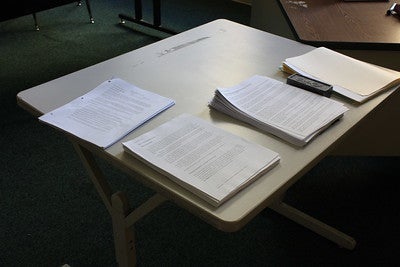
As a technical assistance consultant for teachers who work with learners with combined hearing and vision loss, I am often searching for just the right information to send to teachers. After I have explained something as well as I can, I like to send some follow-up information in a handout. I thought it would be fun to assemble a short list of a few of my favorite resources to share with our blog readers.
One of the important things we want teachers of learners with DeafBlindness to know is how to create defined spaces and active learning areas for their learners where they can learn to explore their environment in a predictable and accessible environment. This encourages movement and development of fine motor skills as well as helps to develop concepts such as object permanence. I was lucky enough to work with the amazing Susan Shier-Lowery when she was an O&M with the Early Intervention vision program in NC. As far as I’m concerned, she wrote the definitive article on “defined spaces!”
Defined Spaces: How to Create Big and Small Playspaces for Children Who are Visually Impaired
Closely related to defined spaces are the techniques outlined in the work of Lilli Nielson which she called Active Learning. Her website activelearningspace.org has lots of information about this teaching method. I like to share the article “Getting Started with Active Learning” with teachers because it provides an overview of Active Learning information and provides links to a variety of articles. The article shows teachers that Active Learning is more than a piece of equipment such as the “little room.” It is a complete learning approach with its own principles and assessments etc.
https://activelearningspace.org/wp-content/uploads/2022/04/GettingStartedWithActiveLearning_rev3.22.pdf
An excellent article that helps teachers think about the basic principles of communication is “Strategies for Creating Communication-Rich Environments for Children who are Deaf-Blind” by Maurice Belote, CDBS Project Coordinator. This article gives teachers food for thought about what a person’s basic rights to communication are and what it takes to achieve them.
https://5871e0203a.clvaw-cdnwnd.com/5f010285cae218a5d7d72c47c1fa8f71/200000122-bec06bfba8/39CommRichEnviro.pdf
Finally, I would like to share a YouTube video from Idaho Children and Youth with DeafBlindness called “The Pause” about the important concept of “wait time.” Wait time is sometimes a difficult concept to get across. Teachers and therapists have limited time to work with their learners with deafblindness so they naturally want to be “doing something” for the entire time of the session. It is so important however that our learners are given enough time to process what is happening and map out a response. If the child is always manipulated to do something they are little more than puppets and are not learning how to interact with others or do things for themselves. We need to learn to expect participation and response from our learners. Sometimes seeing a technique in action can help.
These are just a few of the many articles, videos, and handouts I have collected over the years. Good clear information is often hard to find and when I attend training I make sure to check out the resources they provide and save the ones I like. Teachers can share resources like this with other team members and with families. I encourage teachers to start collecting folders of information that would make good handouts on topics related to their educational goals.
Patty Dischinger, M.Ed.
Technical Assistance Consultant
East Carolina University Teacher Support Program
